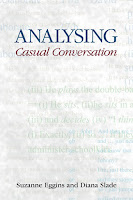This is what great linguistic analysis looks like. Eggins & Slade took a seemingly impossible object of analysis and through careful application of key principles reveal significant insights into the apparently random phenomenon of conversation. Synthesising insights from conversation analysis into a systemic functional framework they introduce us through sympathetic prose to a model that will inform the linguistic analysis of conversation for years to come.
Another lazy Goodreads steal.
Saturday, January 27, 2018
Tuesday, January 2, 2018
Words on the brain
The Visual Thesaurus (see this earlier posting and this link) may not just be a representation, according to this research: Alexander G. Huth, Wendy A. De Heer, Thomas L. Griffiths, Frédéric E. Theunissen, & Jack L. Gallant. (2016). Natural speech reveals the semantic maps that tile human cerebral cortex. Nature, 532(7600), 453-8.
 In this study, subjects were placed in an fMRI scanner while listening to stories, and measurements
In this study, subjects were placed in an fMRI scanner while listening to stories, and measurements
were taken in order to correlate blood flow with the words from the story. What they found, perhaps surprisingly, is that across subjects, words cluster semantically across all regions of the brain, producing clustered networks of semantically related words, much like the visual thesaurus. That is, words with a similar meaning appear to be associated within the same small area of the brain.
You can explore these relations and see the sample lexical items that were matched up in the stories in the experiments from the website here. The tour also shows how you can adjust the settings to view more detail and adjust the image. As well as the astonishing results, the visualisations that realise the findings are amazing.
Although it is not especially new, the paper and the website offer a valuable insight into semantic mapping. What we now need is a similar study that allows a more dynamic approach so that the networks and relationships between all of these items and clusters can also be mapped.
 In this study, subjects were placed in an fMRI scanner while listening to stories, and measurements
In this study, subjects were placed in an fMRI scanner while listening to stories, and measurements were taken in order to correlate blood flow with the words from the story. What they found, perhaps surprisingly, is that across subjects, words cluster semantically across all regions of the brain, producing clustered networks of semantically related words, much like the visual thesaurus. That is, words with a similar meaning appear to be associated within the same small area of the brain.
You can explore these relations and see the sample lexical items that were matched up in the stories in the experiments from the website here. The tour also shows how you can adjust the settings to view more detail and adjust the image. As well as the astonishing results, the visualisations that realise the findings are amazing.
Although it is not especially new, the paper and the website offer a valuable insight into semantic mapping. What we now need is a similar study that allows a more dynamic approach so that the networks and relationships between all of these items and clusters can also be mapped.
Subscribe to:
Comments (Atom)






















